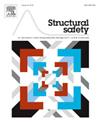Life safety in the Reliability-Based design and assessment of structures
IF 6.3
1区 工程技术
Q1 ENGINEERING, CIVIL
引用次数: 0
Abstract
We review the developments in life safety and the incorporation thereof in the design and assessment of structures over the last 50 years. Various measures of life safety are presented that have been developed according to the marginal life saving cost principle based on individual, societal and economic considerations. Target probabilities of failure, or target reliabilities, are central to modern structural design and assessment. These are derived either through back-calibration to existing practice or through life cycle cost minimisation, both of which yield comparable safety levels, and are underpinned by lower bounds from life safety. Life cycle cost minimisation is reviewed here, which considers all direct and indirect costs of failure including loss of life and limb, as well as the costs and efficiency of increasing reliability. We discuss the incorporation of life safety into reliability-based design and assessment through the concept of the Life Quality Index, which uses key societal indicators, namely, the GDP and life expectancy, and health economics as a basis for specifying minimum reliabilities for both new and existing structures. The current state of advancement of reliability- and risk-informed design, and recommendations for future developments in life safety are considered.
基于可靠性的结构设计和评估中的生命安全问题
我们回顾了过去50年来生命安全的发展及其在结构设计和评估中的应用。根据基于个人、社会和经济考虑的边际生命节约成本原则,提出了各种生命安全措施。目标失效概率或目标可靠性是现代结构设计和评估的核心。这些都是通过对现有实践的反向校准或通过生命周期成本最小化得出的,这两种方法都能产生相当的安全水平,并以生命安全的下限为基础。本文回顾了寿命周期成本最小化,它考虑了故障的所有直接和间接成本,包括生命和肢体的损失,以及提高可靠性的成本和效率。我们通过生命质量指数的概念讨论了将生命安全纳入基于可靠性的设计和评估,该指数使用关键的社会指标,即GDP和预期寿命,以及健康经济学作为指定新结构和现有结构的最低可靠性的基础。考虑了可靠性和风险知情设计的发展现状,以及对未来生命安全发展的建议。
本文章由计算机程序翻译,如有差异,请以英文原文为准。
求助全文
约1分钟内获得全文
求助全文
来源期刊

Structural Safety
工程技术-工程:土木
CiteScore
11.30
自引率
8.60%
发文量
67
审稿时长
53 days
期刊介绍:
Structural Safety is an international journal devoted to integrated risk assessment for a wide range of constructed facilities such as buildings, bridges, earth structures, offshore facilities, dams, lifelines and nuclear structural systems. Its purpose is to foster communication about risk and reliability among technical disciplines involved in design and construction, and to enhance the use of risk management in the constructed environment
 求助内容:
求助内容: 应助结果提醒方式:
应助结果提醒方式:


